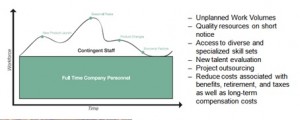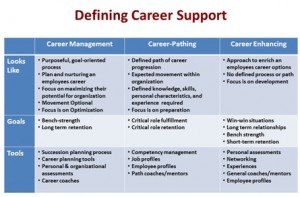Published on
How iLearn! How iWork! – Working In A Blended Workforce Part 2

The Blended Workforce has been growing for years, mainly from outsourcing repeatable human tasks – janitorial service, lawn care, trash disposal, etc.. These were alternatives to full-time employees at lower costs and, in the majority of instances, work performed better and more efficiently allowing employers to hire high value workers with computational and critical path skills. Audit firms with access to clients’ books, could find more ways to “outsource” work to lower cost of labor and provide specialized skills on-demand to meet the changes required to remain competitive. Thus began the era of big consulting firms like Price Waterhouse Coopers, Ernst & Young, KPMG, Accenture, etc, who were contracted for more complex and longer term projects, like deployment of ERP systems.
“The nature of work is changing. Because of technology, we’re able to work from anywhere, at any time, and not just from home or from Starbucks, but from India. That’s changed the way some employers look for employees. They recognize they’re always going to want to have a contingent workforce and to staff up or down to meet their needs” – Melanie Holmes, Vice President of Staffing Agency Manpower
Today between 40% and 50% of total labor costs of an organization is not done by full time employees on payroll getting a W-2. Another 20% are the contracted services noted above. The balance of the total workforce is a variable depending on the needs of the organization for talent to meet ever changing (get used to it if you are not yet adjusted to constant change in the workplace) business decisions regarding markets, products, distribution, competition and so on.
The facts are that agile enterprises will need to be flexible in order to respond more quickly to the challenges ahead. They will need that specialized talent temporarily as the cycles of market, products and competition shift at different speeds over time. There is a growing supply specialized talent that organizations won’t hire as employees and then have to terminate them when the activity, scope of work, or project is completed for that cycle. Therefore, there will be a need to continuously add and delete temporary specialized talent.
CxOs will need to eliminate silos in their organization, form cross functional teams of full time, part-time, temp and contract worker based on the talent drivers needed to meet business goals. They will also need better or improved management tools to gain real-time visibility into the full labor force costs, risk, talent opportunities needs and forecasting.
Another factor of influence in the composition of a workforce in continuing fluidity is generational shifts in the workforce populations as we mentioned in last week’s Part 1. Along with those changes come different work expectations as charted below.
Tomorrow as described in the chart above has already arrived. Gen Y workers all have at least one Smart device (laptop, iPhone, tablet, etc.) used as a phone, web browser, search, texting, social networking, etc. They bring those skills of use with them and want your company to hook them into your network upon arrival. They don’t want another device. After all they have their friends, contacts, Facebook, Yahoo, LinkedIn account already on them and pictures, videos, games, etc. They don’t understand why you can’t let them use their already capable device to which they are connected 24/7. Many organizations are working round the clock to address the security and connectivity issues of bringing your own device (BYOD) into the work environment.
Insuring your blended workforce environment can develop a career path for those full time employees is also a necessity. The Gen Y’ers will want constant feedback, to a fault, on how they are progressing and major involvement in what’s available to them in various forms of learning to advance their career. They like to make choices which they believe best fits their ability to capture information and translate to productive work. This will rake havoc for HR and Learning Leaders who most like conformity and repeatability. The matrix below is just a hint of many levels of learning and career-pathing necessary to retain talent.
Fact: Remember there is now a widening gap of available talent in certain fields. As mentioned last week, the mix and size of the talent pool is changing and shrinking. It is the new “Normal”. But increasingly, specialized talent will prefer working on a team with a SoW and milestones knowing their work has a beginning and an end. Much of that activity will be in a virtual environments connected by a global clock.
That means managers will be managing multiple generations with differing life experiences and values in ever changing teams of employees, independent contractors, temps, contingent workers, etc. The film industry has been making movies very successfully this way for decades.
So, what’s the big deal? We’re not ready for this. Resistance to change is always high. To many, this is instability at its worst. Deep bias and belief systems get challenged and need to be flushed out. However, many educators and business leaders just ignore these facts, just as we have ignored the abuse and deterioration of our education system. Business as usual or “not my job”, they say. If that’s you, hold on tight because a major tsunami is coming.
Skills, Proficiency, Promises, and Performance Mastery gets you there. That’s HOW iLearn and HOW iWork!
NEXT WEEK IN How iLearn! How iWork!: Connecting a Disbursed Workforce
Author Perspective: Business






